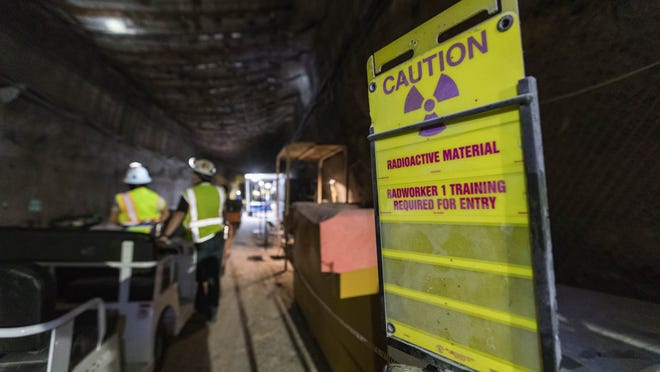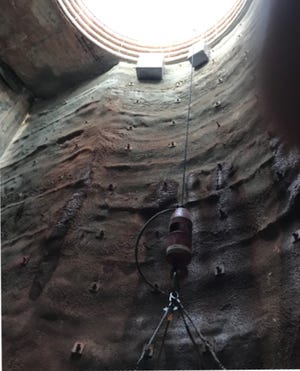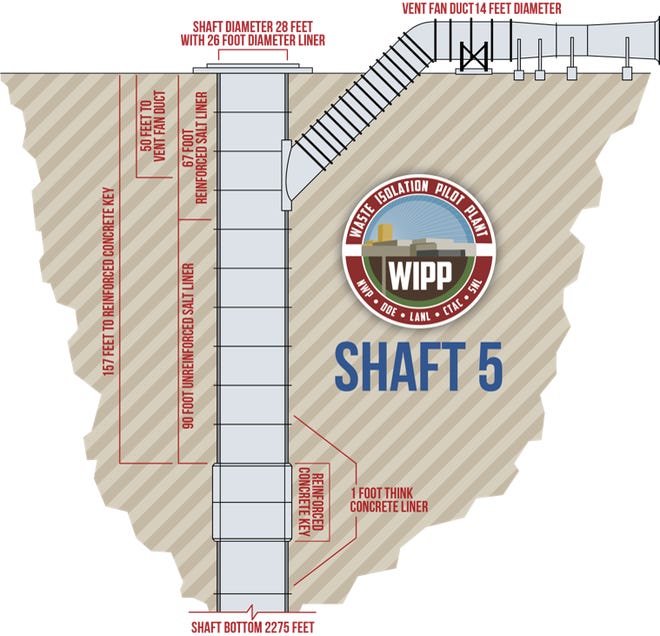
A modification to a wastewater discharge permit at the Waste Isolation Pilot Plant nuclear waste repository near Carlsbad drew concerns the change could support the construction of a controversial utility shaft planned at the facility.
Construction of the shaft was recently paused by the New Mexico Environment Department when it denied renewal of a temporary authorization for the work ahead of required permit modification needed to use the shaft.
It would pull air into the underground where workers mine space for the waste and permanently emplace it in disposal panels.
More:WIPP: New panels to dispose of nuclear waste
Transuranic (TRU) waste consisting of clothing materials and equipment irradiated during nuclear activities is disposed of at WIPP by setting it in the underground salt deposit, about 2,000 feet underground, where salt is allowed to collapse in, blocking the radiation and entombing the waste.
The shaft could also provide better access to the western side of the mine where two new panels were expected to be constructed to replace space lost during an accidental radiological release in 2014.
To build and use the shaft, the U.S. Department of Energy could need more capacity to manage non-radioactive wastewater, and for the salt being mined for the project.
More:WIPP takes in 100th shipment from Tennessee facility since 2014 incident
That’s why the site’s discharge permit included an additional salt cell to hold the salt and a salt pond to hold the water. It also included three other discharge points associated with another project to rebuild WIPP’s ventilation system.

John Heaton, chair of the Carlsbad Mayor’s Nuclear Task Force said the change was “straight-forward” and was needed to provide additional capacity for water management at the facility.
During a recent hearing before the New Mexico Environment Department, which oversees the permit, Heaton said there was no evidence presented by opponents that the additional facilities did not meet the state’s requirements.
More:Nuclear waste facility near Carlsbad sees COVID-19 surge as infections rise in New Mexico
“The fact that there are some changes going on at WIPP and there is need for those additional impoundments is very straightforward,” Heaton said.
“Obviously, the various impoundments they need to prepare for those with the shaft going forward or whatever else is happening at the site. It’s the responsible thing to do to control that water.”
But critics of WIPP and of the proposal alleged its connection to the utility shaft, which was as of yet not approved in the facility’s permit, argued the two discharge points related to shaft should not be allowed, questioning their purpose.
More:WIPP: Lawmakers briefed on plans to up nuclear waste shipments to facility near Carlsbad
Don Hancock with the watchdog group the Southwest Research and Information Center (SRIC), who spoke during the hearing’s public comment period said his objection to the change in the discharge permit was directly tied to his opposition to the shaft itself.
“What’s controversial is the new shaft which we’re opposing. What my organization was saying is we wouldn’t be objecting except for these two new discharge points that are for something that is not permitted,” Hancock said.
“It’s not the discharge permit itself that is controversial. It’s a part of something that is unpermitted. They had to do the renewal anyway so that wanted to get it all done at once.”
More:WIPP: $100 million contract awarded for tech support at nuclear waste site near Carlsbad

Hancock said he and other groups opposing the utility shaft project and associated discharge points hoped NMED would remove the salt cell and pond associated with the utility shaft from the permit.
“There’s no purpose for it,” he said. “If Shaft 5 never gets permitted and built, you don’t need Salt Cell 5 and Salt Pond 5. We think those two things should be deleted and not approved.”
But the hearing wasn’t about the shaft, Heaton said, it was about the additional discharge units and no one during the two-day hearing, he contended, presented any reason why the proposal did not meet state requirements.
More:Pushing ahead: Ongoing work at Waste Isolation Pilot Plant advances nuclear waste mission
That means they should be able to be built regardless of their purpose, he said, to help mitigate WIPP’s potential environmental impact on ground water.
“It’s always confounding to me that people like SRIC will oppose these things when it’s the responsible thing to do to protect the environment. It’s absolutely not controversial,” Heaton said.
“Frankly, WIPP meets all of the legal conditions that are in place for those ponds. There’s not any question about that. If you want to go out and build a pond, and you meet all the requirements, you should be allowed to do that.”
Adrian Hedden can be reached at 575-618-7631, achedden@currentargus.com or @AdrianHedden on Twitter.






